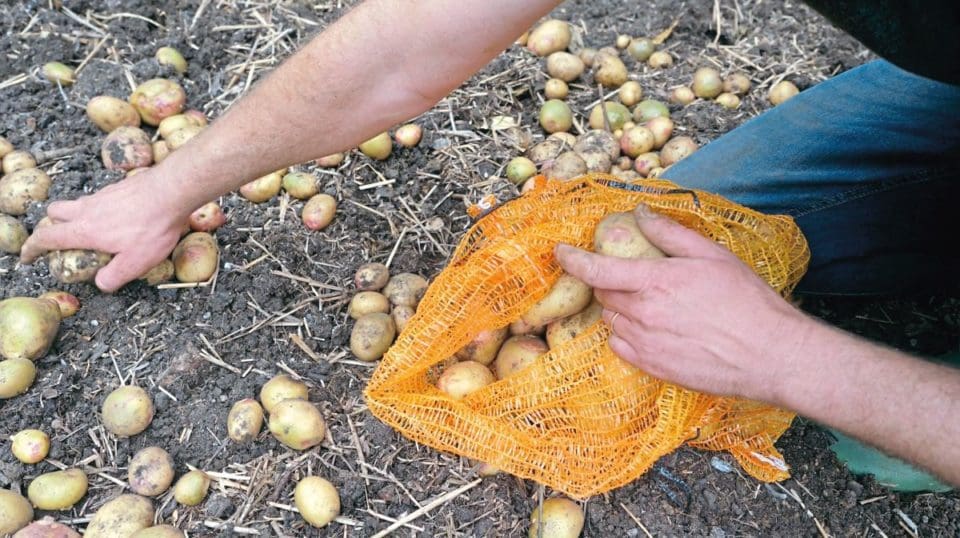Ben Vanheems shares some essential tasks to carry out in your garden and allotment for September.
SOW NOW
Endive, lettuce, Oriental leaves, rocket, salad leaves, spinach, spring onion, radishes
PLANT NOW
Spring cabbage, lettuce, onion sets, salad leaves, strawberries
HARVEST
Aubergine, beetroot, Brussels sprouts, endive, French and runner beans, broccoli, cabbage, carrots, cauliflower, celery, celeriac, chicory, chillies and peppers, courgettes, cucumber, Florence fennel, garlic, globe artichoke, kohl rabi, leeks, lettuce, onions, peas, potatoes, radish, salad leaves, shallots, spinach, spring onion, squash, strawberries, sweetcorn, sweet potato, swede, Swiss chard, tomatoes, turnips
Fill the larder!
September is a time of crossover, when summer staples like beans and courgettes are still coming thick and fast, joined by the first of autumn’s abundance.
The biggest job is simply keeping on top of the harvesting. It may feel like the good times will never end but spend some extra time now processing all those gluts and you’ll be so pleased you did when the leaner months come. Pickle, dehydrate, freeze, bottle or cook up into sauces – you have many options for putting away some of the excess for later.
Savour the last of the sweetcorn and tuck into the first of the maincrop potatoes. Also ready to harvest are the very earliest leeks, the start of the kale, as well as the first of the hardy roots and tubers, including celeriac, parsnips and Jerusalem artichoke.
With both summer and winter flavours to sample, this is a very special moment and just reward for all those hours of hard work.
Plant spring cabbages
Set into firm ground in rows 30cm (1ft) apart. Space transplants 15cm (6in) within the row. In spring you can thin every other plant to enjoy as greens, leaving the rest to heart up.
Clear spent crops
Lift up old crops and pick off dead leaves to keep things clean and tidy. Add everything to the compost heap. Dig out mature compost to make space.
Help squash ripen
It’s the final push for winter squash and pumpkins. Lift developing fruits off the soil on to slates or tiles to stop them rotting. Keep applying a liquid feed.
Sow salads
Finish sowing salads for winter cropping, including lettuce, rocket, corn salad and winter purslane. Don’t forget to water if it’s still quite warm and dry.
Freeze harvests
STEP 1: Freezing is a convenient way to store the last of the summer gluts. Pick produce at its peak, wash then prepare in batches to freeze as soon as possible. Top and tail beans, shuck corn to save on freezer space, and cut celery into inch-long sections.
STEP 2: Bring a large pan of lightly salted water to a rolling boil then drop in your prepped produce. Blanch thin/small vegetables like beans for two minutes, and larger veg like carrots for three to four. Once the time is up, transfer the produce to icy water to stop it cooking.
STEP 3: Pat dry then pack portion-sized quantities into freezer bags. Label with the contents and date so you know what you have at a glance. Use a straw to suck out as much air as you can before sealing. This prevents freezer burn. Frozen produce should keep for up to a year.
Lift maincrop potatoes

Maincrop potatoes are ready to harvest. Don’t leave them too long or the slugs may start to show an interest too. Begin by cutting down the haulms (potato foliage) to within an inch or so of the ground as they die back. Dig up the potatoes on a dry day a few weeks later. Maincrop spuds store well. Let them dry off on the soil surface for a few hours then pack them into hessian, net, or paper sacks. Inspect each potato before storing – damaged or diseased tubers could spoil the rest of the sack so set them aside to eat first. Store your spuds somewhere cool and dark.
Pests & Problems
■ ROSEMARY BEETLE: These handsome beetles and their larvae feed on herbs such as lavender, sage and rosemary. Plants rebound from mild attacks but if there are lots of beetles, spread newspaper beneath the plant, shake them off then gather them up.
■ POWDERY MILDEW: This fungal disease often strikes by early autumn. Squash family plants are particularly susceptible. Keep plants properly watered to slow its onset but, in the end, the tell-tale powdery white coating is inevitable. Lift and compost plants.
■ LEEK MOTHS: Their sneaky caterpillars feed on the leaves and tunnel into the stems, causing serious damage. Check over plants and destroy any white, silk-like cocoons you discover. Crops can also be covered with insect mesh or fleece to exclude the moths.
Under cover
Collect more water
After the warmer months you may find water butts running low or empty. How often did they dry up and could you do with installing more? Rainwater is naturally best for your plants and a greenhouse roof is the obvious place to install the means to collect this precious resource. Water butts set up now will have all winter to fill up, leaving you with a fresh cache of the wet stuff by spring.
If you need to install guttering, look out for gutter kits specific to your greenhouse – check with the manufacturer. It is easy to source your own though. Measure the length of the roof, buy enough gutter to fit or saw to size. You will also need an end stop, downpipe, and brackets, screwed to the greenhouse frame, to hold the gutter in place. Raise the water butt on to a stand or blocks so you can get in with a watering can.
Autumn clean
We’ve all heard of a spring clean, but a thorough autumn clean can be just as powerful, particularly in the greenhouse. As summer crops come to an end, seize the chance for a good clearout. This will deny pests and diseases places to hide out the winter.
Old compost should be removed from the greenhouse. Dump it on to beds or add it to the compost heap along with plenty of fresh material. Dead and decaying foliage should also be taken outside for composting. Spick and span is the order of the day to break the cycle of problems.
Propagate strawberries
STEP 1: Strawberry plants slow down significantly after three years and are best replaced. The simplest way to do that is to propagate new plants using the long runners produced by existing plants. Each cluster of leaves along the runner can produce a new plant.
STEP 2: Pin the cluster nearest the mother plant down on to a pot of well-drained compost. This will make it easy to replant once it has rooted. Use a U-shaped wire to hold the leaf cluster down on to the compost, ensuring the base is in good contact.
STEP 3: The runner will root within about four weeks and new growth will be visible. Cut it free from the mother plant and, once it has grown on a bit more, pot on into a larger container or plant it outside into a new area of ground. The plants will fruit next season.
Pot up herbs

Herbs bring meals to life. Make sure you have fresh herbs to hand for longer by digging and potting up some leafy herbs to enjoy beyond summer. Dig up a clump and pot up the healthiest sections into containers slightly bigger than the root ball. Use fresh compost and feed it all the way around the roots. Trim old, straggly growth to encourage fresh shoots.
Herbs including mint, thyme, chives, oregano and parsley can all be grown on this way. Keep your potted herbs in the greenhouse for the first few weeks then move them indoors to a bright windowsill once it turns frosty. You can help them transition to the indoors by bringing them in overnight to begin with.
Key Jobs for September
■ REMOVE SHADING
As the month progresses temperatures will start to drop, most noticeably at night. It’s time to reverse gear and trap more heat. Wash and brush off shade paint in several stages over a few weeks, so that light levels gradually increase as the sun’s strength weakens.
■ LOCK IN WARMTH
Shut all vents, windows and doors by late afternoon to hold on to as much of the remaining daytime heat as possible before night falls. Warmer overnight temperatures will encourage crops to continue ripening, effectively extending summer well into October.
■ SOW SALADS
Continue sowing winter salads. Lettuce, endive and hardy leaves like rocket, mustards and mizuna may be sown into grow bags, containers or beds recently vacated by an earlier summer crop. If these are still occupied, sow into modules or pots to plant out in a few weeks.
■ WATER EARLY
Whether growing outside or under cover, it’s best to water your crops in the morning if possible. This gives the soil surface and foliage an opportunity to dry out over the course of the day, greatly reducing the risk of plant diseases such as tomato blight and botrytis.











